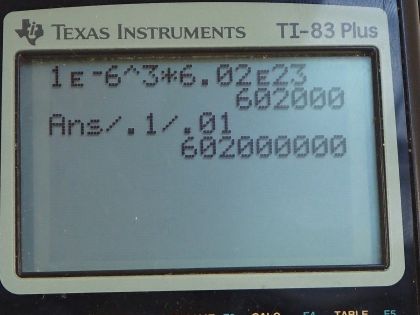Question
(a) What is the volume (in ) of Avogadro’s number of sand grains if each grain is a cube and has sides that are 1.0 mm long? (b) How many kilometers of beaches in length would this cover if the beach averages 100 m in width and 10.0 m in depth? Neglect air spaces between grains.
Final Answer
- . This is greater than the distance to the sun! ()
Solution video
OpenStax College Physics, Chapter 13, Problem 30 (Problems & Exercises)

vote with a rating of
votes with an average rating of
.
Calculator Screenshots
Video Transcript
This is College Physics Answers with Shaun Dychko. We assume that we have a whole bunch of grains of sand that are cubes with side lengths of a one millimeter. And the question in part A is: what volume of these grains of sand would you have if you had as many grains as Avogadro's number? So we have 6.02 times 10 to the 23 pieces of sand that are cubes of side length one millimeter And it says: give the answer in kilometers cubed. So we'll change the side length into kilometers by first saying that the prefix milli means multiply by 10 to the minus three and so that converts to meters, and then we multiply by one kilometer for every 1000 meters and that gives 1.00 times 10 to the minus 6 kilometers is the side length of a cube. So the volume of all the cubes is going to be the length times width times height of one of them multiplied by the number of them which is Avogadro's number. So I could have done the side length cubed instead of going 1.0 times 10 to the minus 6 kilometers multiplied by itself three times and then multiply that by 6.02 times 10 to the 23 Avogadro's number and we get 6.0 times 10 to the five cubic kilometers of volume. And then in part B it says: suppose you have a beach with a width of 100 meters and a depth of 10 meters, how long will the beach be? What is L in other words? So we know the volume of all the sand from part A and that is going to equal the length of the beach times its width times the depth. Now, since our volume is in cubic kilometers, let's express the width and depth that we're given in kilometers as well. So 100 meters times one kilometer for every 1000 meters is 0.1 kilometers and the depth is 0.01 kilometers. So we solve for L by dividing both sides by W times D and we get that the L then is the volume divided by the width times the depth. So it's 6.02 times 10 to the five kilometers cubed divided by 0.1 kilometers times 0.01 kilometers which is 6.02 times 10 to the eight kilometers. And that is greater than the distance of the sand which is only one and a half times 10 to the eight kilometers. So Avogadro's number is a really big number in other words.
